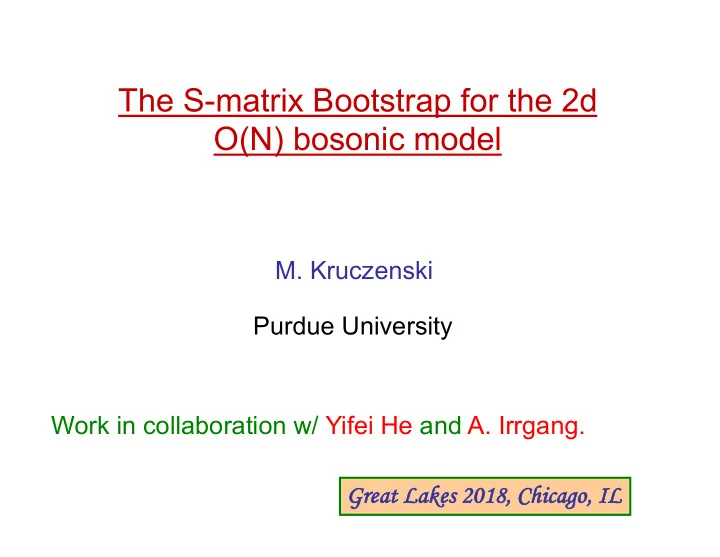

The S-matrix Bootstrap for the 2d O(N) bosonic model M. Kruczenski Purdue University Work in collaboration w/ Yifei He and A. Irrgang. Gr Great t La Lakes s 2018, Chicago, IL
Summary ● Introduction and Motivation Define a field theory by a maximization problem in the space of allowed S-matrices Simple example of S-matrix bootstrap: coupling as a functional Maximizing linear functionals in convex spaces: vertices Should apply to theories without continuous parameters (or parameters are fixed) 2
● The 2d O(N) model from S-matrix bootstrap The O(N) model (exact S matrices) The O(N) model from a convex maximization problem. ● CDD factors and zero modes More detailed structure of the space of theories. ● Conclusions 3
S-matrix bootstrap The S-matrix satisfies constraints from analyticity, unitarity and crossing. In the allowed space one can consider a functional and define a theory by the S-matrix that maximizes such functional. A standard example is the coupling between a particle and its bound states (whose spectrum is assumed fixed). There is a maximum coupling because increasing the coupling further adds more bound states. Paulos, Penedones, Toledo, van Rees, Vieira 4 2d O(N) model has no bound states ….
Example: (Paulos, Penedones, Toledo, van Rees, Vieira) 2d theory, two species of particles of masses 𝑛 and 𝑛 " = 2𝑛 sin ( ") where 𝛿 is a real parameter. m m 1 p 1 p 2 =-p 1 m p 2 =-p 1 p 1 - and 𝑡 - = 4𝑛 - − 𝑛 " - . (t=4m 2 -s) Poles at 𝑡 " = 𝑛 " cos 𝛿 8 7 𝑨 , 𝑇 = 𝑨 − 𝑗𝑏 − 𝑨 + 𝑗𝑏 + 𝑇 𝑏 = , 1 + sin 𝛿 8 ∶ coupling constant. 𝑇 𝑨 ≤ 1 at the boundary of the disk. 5
q s i p 0 4m 2 0 i z 6 -i
If, under those constraints, we maximize the parameter we obtain a simple result: ?@A = 1 − 𝑏 B 7 ?@A 𝑨 = 𝑗𝑏 - , , 𝑇 2𝑏 sinh θ + 𝑗 sin 𝛿 𝑇 𝑛𝑏𝑦 (𝑨) = 𝑗 1 + 𝑏 - 𝑨 - 8 𝑨 - + 𝑏 - = sinh θ − 𝑗 sin 𝛿 8 Quite interestingly, 𝑇 ?@A 𝑨 saturates the bounds and matches the S-matrix of two elementary particles associated with the scalar field in the sine-Gordon model. Thus, we see the S-matrix of a well-known model arising from such a simple maximization problem. 7
Maximizing linear functionals in convex spaces: vertices Maximizing a linear functional in a convex space is easy. There is only one local=global minimum and it is one of the vertices. Which one depends on the direction 8 of the gradient.
9 The 2d O(N) model: N species of bosons w/ mass m S-matrix p 1 , a p 2 , b p 4 , d p 3 , c
10 Exact result using YBE (Zamolodchikov-Zamolodchikov)
11 General properties of the S matrix Unitarity Considering a subspace D in a subspace or, equivalently, Defines a convex space of allowed S D matrices
Here: s>4m 2 Crossing With a linear constraint the space remains convex 12
In this space we consider a linear functional: Maximize F subject to the crossing constraints and unitarity bounds. We do not use factorization (YBE). 13
N=5 maximization result vs integrable model on the physical line 1 ReS I ReS + ReS - 0.5 0 -0.5 -1 -5 -4 -3 -2 -1 0 1 2 3 4 5 Re 3 1 ImS I ImS + ImS - 0.5 0 -0.5 -1 -5 -4 -3 -2 -1 0 1 2 3 4 5 Re 3 14
N=20 Maximization result vs integrable model on the physical line 1 ReS I ReS + ReS - 0.5 0 -0.5 -1 -5 -4 -3 -2 -1 0 1 2 3 4 5 Re 3 1 ImS I ImS + ImS - 0.5 0 -0.5 -1 -5 -4 -3 -2 -1 0 1 2 3 4 5 Re 3 15
N=100 Maximization result vs integrable model on the physical line 1 ReS I ReS + ReS - 0.5 0 -0.5 -1 -5 -4 -3 -2 -1 0 1 2 3 4 5 Re 3 1 ImS I ImS + ImS - 0.5 0 -0.5 -1 -5 -4 -3 -2 -1 0 1 2 3 4 5 Re 3 16
Vertex: Absence of zero modes Convex polygon 17
A= Fluctuations has no zero modes 18
Iterative improvement of maximization functional A general maximization functional is of the form Starting from we can refine w A by taking an average of the normals: converges fast. 19
Analytical solution from numerics (example N=8) 1 1 0 0 -1 -1 -2 -2 -3 -3 -4 -4 -5 -5 -6 -6 -7 -7 -8 0 /4 /2 3 /4 -8 0 /4 /2 3 /4 From crossing, the position of the zeros, and the S-matrix 20 can be found exactly.
CDD factors and zero modes (Castillejo-Dalitz-Dyson) Have free parameters, it has 6 zero modes. 21
Conclusions The S-matrix bootstrap provides a very interesting way to define a field theory as the maximum of a functional in the space of allowed S-matrices. We argued that such space is convex and therefore, if a linear functional is maximized, the maximum is at the boundary and easily found by standard numerical methods. Certain field theories have no free parameters and should be found at a vertex of such convex space This works well for the 2d O(N) model. 22
Recommend
More recommend